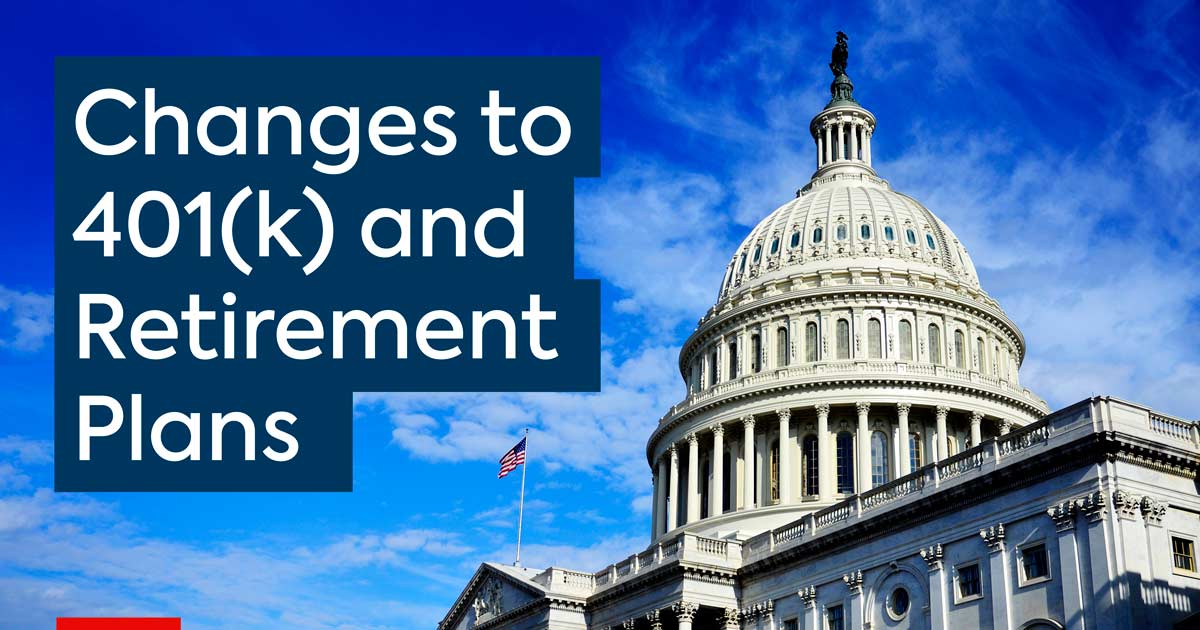
How the New 401(k) Law Impacts Your Retirement Savings
January 3, 2023
 By Ted Hanson
By Ted Hanson
Portfolio ManagerCongress recently passed – and President Biden signed into law – a bill that will make some big changes to 401(k) retirement plans and evolve how Americans save in the future.
Highlights of the SECURE Act 2.0
There are dozens of provisions in the new law — called the "Setting Every Community Up for Retirement Enhancement" (SECURE) Act 2.0. But there are a few highlights in particular that we wanted to cover here.
1) Wait longer before you have to withdraw money.
The age when you are legally required to start taking money out of your retirement plan — called a "required minimum distribution" — increases from age 72 to 73 in 2023, and up to age 75 by 2033. Two important items to note: If you turned 72 in 2022 or earlier, you must keep taking RMDs as scheduled. And if you turn 72 in 2023 and have already scheduled your withdrawal, you might want to consider updating your withdrawal plan.
Meanwhile, the penalty for failing to take an RMD will decrease from 50% to 25% of the RMD amount — and even less (10%) if it is corrected in a timely manner.
2) Have a Roth 401(k)? There is no Required Minimum Distribution.
Starting in 2024, Roth accounts within 401(k) plans, 403(b) plans and 457 plans are no longer subject to the required minimum distribution (RMD) rules listed above. This is meant to help you continue your tax-free growth in a Roth account, even after you retire.
For more information about Roth and other retirement accounts, take our five-minute crash course on Planning for Retirement, part of our free Financial Learning Center.
3) Save more in "catch-up" contributions.
There is a limit to how much you can invest in your retirement account each year. However, the law expands these limits to make room for "catch-up" contributions, so people age 50 or over can save extra money in case they've fallen behind. The new law bumps the maximum "catch-up" amount that can be contributed to a workplace plan from $6,500 to $7,500 per year, effective in 2023. In addition, starting in 2025 if you are age 60 through 63, you will be able to make up to $10,000 in extra contributions each year.
Are you on track for retirement? Find out using our specialized 401K retirement calculator.
4) Add "emergency savings" to your retirement plan.
No longer are you forced to choose between building emergency savings and saving for retirement. Now, you can do both! The new law allows you to set aside up to $2,500 of your retirement plan each year (or lower, as set by your employer) into an “emergency savings plan.” You can make tax- and-penalty-free withdrawals at least 4 times in a calendar year from this part of your plan. Prior to the new law, you might have gotten hit with a tax penalty for prematurely withdrawing money from your 401(k) before you hit age 59½.
5) Pay off student loan debt, while your employer matches for retirement.
Starting in 2024, employers can take the amount an employee is paying toward student loans each month, and match it with a contribution into a retirement account for that employee. This gives companies extra incentive to help workers save, even while they're paying off their educational loans.
6) Part-time employee? You're eligible for a plan.
You are now eligible to participate in an employer's 401(k) plan or 403(b) plan with one year of service of 1,000 hours; or with two consecutive years of service of 500 hours. Before the first SECURE Act, part-time employees usually were not eligible to participate in company retirement plans.
7) Roll over 529 College Plans into a Roth IRA, tax free.
Do you or a loved one still have unused money sitting in a 529 College Savings plan? Thanks to the new law, after 15 years you can now roll over up to $35,000 from a 529 plan into a Roth IRA for the beneficiary, tax free. A few caveats — besides the $35,000 cap, rollovers are subject to the annual Roth IRA contribution limit ($6,500 in 2023); the rollover can only be made to the beneficiary's Roth IRA (not the account owner), and you can't roll over any contributions or earnings made in the last five years.
8) Have more options for giving to charity.
Beginning in 2023, people age 70½ and older may elect a one-time gift up to $50,000 (adjusted annually for inflation), to a charitable remainder unitrust, a charitable remainder annuity trust, or a charitable gift annuity. This is an expansion of the original type of charity that can receive a QCD. If you would like more guidance on getting the most out of your charitable gift, contact our trust department.
9) Find a long-lost retirement plan.
A government website will be created by 2025 to help individuals locate lost retirement accounts from previous employers.
10)Get tax credits for launching a company retirement plan.
For small businesses (50 or fewer employees) that start a new sponsored retirement plan, the tax credit to help cover administrative costs has been increased from $500 to $5,000. In addition, there is another 100% credit of up to $1,000 per employee available, for any contribution for employees earning less than $100,000 during the first year of the plan.
11) Automatically enroll into a company plan.
According to the new law, organizations offering new 401(k) or 403(b) plans must automatically enroll eligible employees into their plans, starting at a contribution rate of at least 3%, in 2025. Here's a pro tip: If your company is considering launching a sponsored retirement plan, our team of experts can help you through the process.
What matters most:
While details are still coming out about the new law, what is clear is that there is a focus on an individual's ability to save for retirement — and that's something we can all get behind.
Saving for retirement can often feel like a daunting task, but the most important step you take is the first one. We want to help you on your journey. If you want to discuss your retirement goals or how the SECURE 2.0 Act may affect you, reach out to an advisor today. Your success matters to us!